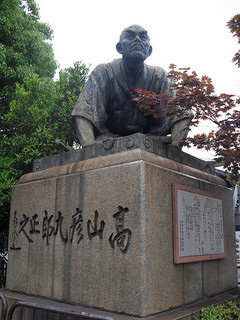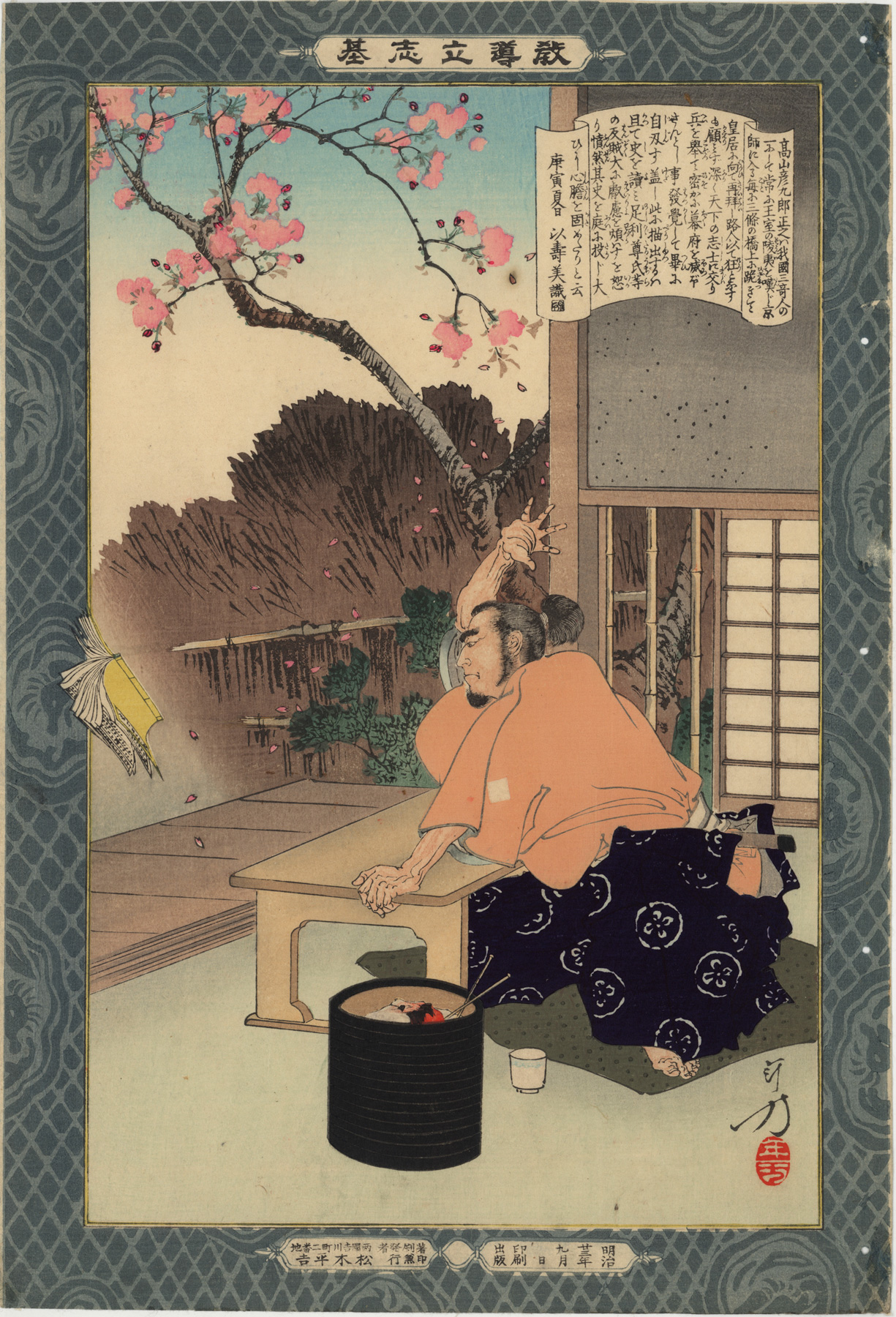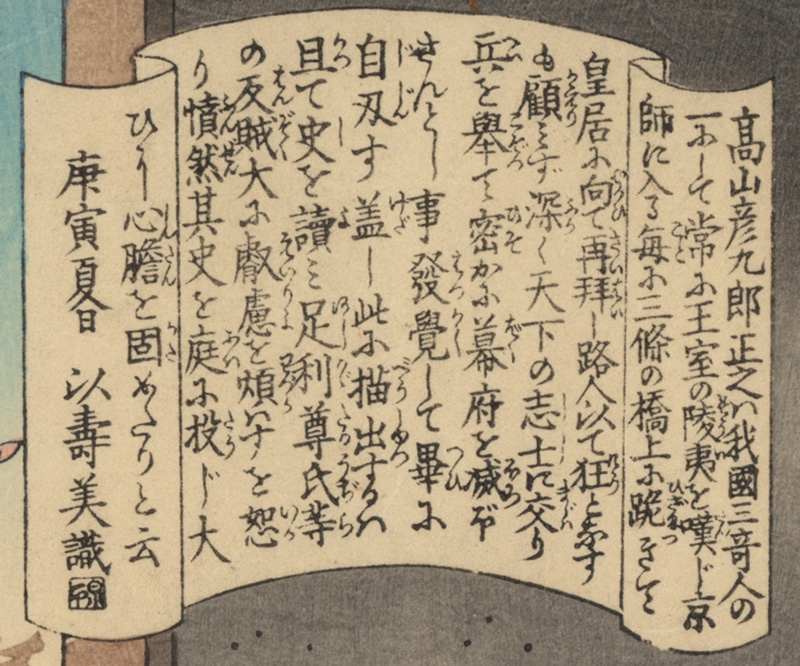About This Print
This unnumbered print1 in the series Instructive Models of Lofty Ambition pictures Takayama Hikokurō (1747-1793) one of the "three eccentrics of the Kansei era" and a fierce proponent of reverence for, and loyalty to, the emperor. In this scene he angrily tosses aside a book about shogun Ashikaga Takauji's usurpation of imperial authority. Ashikaga defeated the Imperial Court in 1336 and established the Ashikaga Shogunate that ruled japan from 1336 to 1573.The artist Mizuno Toshikata contributed 16 prints to this series.
1 Numbering of the prints was haphazard during the production of the series. While this print is unnumbered, the title for this print is shown in the 45th position listed in the Table of Contents for this series (reference Table of Contents from the series Instructive Models of Lofty Ambition). Print numbers were sometimes inadvertently omitted; some prints in the series were never assigned numbers and a few of the same numbers appear on different prints.
Color Variant Impression
Takayama Hikokurō (1747-1793)
Sources: Abstract of the article "The Three Eccentrics of the Kansei Era and the Time of Wondering," Arakawa Hiroshi, appearing in the journal Studies in Humanities 55(2), 1-41, 2005-01-31, Shizuoka University and the website of The Samurai Archives http://wiki.samurai-archives.com/index.php?title=Takayama_HikokuroTakayama Hikokurō Masayuki 高山彦九郎正之 the son of a wealthy farmer in the mid-Edo period was known for his travels across the country and for his strong loyalty to the Emperor. Along with Hayashi Shihei (1738-1793) and Gamō Kunpei (1768-1813), he was known as one of the "three eccentrics (Sankijin) of the Kansei era" (January 1789 through February 1801).

Statue of Takayama Hikokurō at Sanjō-Kawabata, in Kyoto
It is believed he may have been involved in attempts to re-establish the Daigaku-ryō ("Imperial Academy"), and perhaps was even an early advocate of the restoration of Imperial rule, long before the sonnō jōi [revere the emperor, expel the barbarians] movement of the 1850s-60s.
Hikokurō later traveled around the country, crossing paths with figures such as Fujita Yūkoku, Tachibana Nankei and Nakayama Naruchika, but while traveling in Kyushu, he became the object of an investigation by shogunate authorities; this ended in his suicide, on 1793/6/27, in Kurume (in Fukuoka han). His travel diary is a prominent, oft-cited/studied example of Edo period travel writing.
Hikokurō later traveled around the country, crossing paths with figures such as Fujita Yūkoku, Tachibana Nankei and Nakayama Naruchika, but while traveling in Kyushu, he became the object of an investigation by shogunate authorities; this ended in his suicide, on 1793/6/27, in Kurume (in Fukuoka han). His travel diary is a prominent, oft-cited/studied example of Edo period travel writing.
* this story is also dated from 1783 by some sources
Transcription of Scroll
Source: with thanks to Yajifun http://yajifun.tumblr.com/
“高山彦九郎正之ハ我國三奇人一にして常に王室の陵夷を嘆じ京師に入る毎に三條の橋上に跪きて皇居に向て再拜し路人以て狂となすも顧ミず深く天下の志士に交り兵を擧(こぞつ)て密かに幕府を滅ぼさんとし事發覺(発覚)して畢に自刃す 蓋し此に描出するハ且て史を讀ミ足利尊氏等の反賊大に叡慮を煩ハすを恕り憤然其史を庭に投じ大ひに心膽を固めたりと云 庚寅夏日 以壽美 識”click on image to enlarge
About The Series "Kyōdō risshi no motoi"
Notes:1. This series is variously translated as "Instructive Models of Lofty Ambition," "Foundations of Learning and Achievement," "Foundation of Instruction and Perseverance," "Self-Made Men Worthy of Emulation," "Paragons of Instruction and Success," "Moral of Success," "Examples of Self-Made Leaders," and "Instruction in the Fundamentals of Success." The title in Japanese is sometimes seen as "Kyōdō risshiki or "Kyōdō risshi no moto," in addition to the most commonly seen transliteration of "Kyōdō risshi no motoi".2. For a complete listing of all the prints in the series and additional information please see the article on this site titled Instructive Models of Lofty Ambition.
This series ran between October 1885 and November 1890 and featured a long list of heroes and heroines, from antiquity to contemporary times, who were regarded as standards of moral leadership and self-realization.
Source: Kiyochika Artist of Meiji Japan, Henry D. Smith II, Santa Barbara Museum of Art, 1988, p. 74-75; original research and as footnoted.
This series of 58 prints,1 plus a table of contents sheet (目録), were originally published between October 1885 and November 1890 by the Tokyo publisher Matsuki Heikichi 松木平吉.2 The table of contents sheet issued by the publisher states that "fifty prints make up the complete set (五十番揃)". Three prints not in the initial release were added over the five year publication period, as were five redesigns of original prints, eventually increasing the total print count to 58. The seven artists contributing prints were Kobayashi Kiyochika (1847-1915) [20 prints], Mizuno Toshikata (1866-1908) [16 prints], Inoue Tankei (Yasuji) (1864-1889) [13 prints], Taiso (Tsukioka) Yoshitoshi (1839-1892) [5 prints], Yōshū Chikanobu (1838-1912) [2 prints], Toyohara Kunichika (1835–1900) [1 print], and Hachisuka (Utagawa) Kuniaki II (1835-1888) [1 print]. All the artists, with the exception of Yōshū Chikanobu, are listed in the top scroll of the table of contents sheet. Various colors (including blue, blue/green, and tan/brown) were used for the decorative border, and in 1902 the series was re-issued by Matsuki without borders.
Brief texts contained within a scroll-like cartouche appearing on each print provide historical details. The scroll composer's name is given at the end of the scroll text. The “lofty ambition” of the title is a Confucian concept, originally from Mencius, meaning “righteous determination that would inspire others.” The market for the series probably included former samurai, ambitious youth, and conservative intellectuals.
"[W]hen it was completed in 1890 the publisher was singled out for special recognition by the government for having sponsored such noble subject matter."3
This series ran between October 1885 and November 1890 and featured a long list of heroes and heroines, from antiquity to contemporary times, who were regarded as standards of moral leadership and self-realization.
Source: Kiyochika Artist of Meiji Japan, Henry D. Smith II, Santa Barbara Museum of Art, 1988, p. 74-75; original research and as footnoted.
This series of 58 prints,1 plus a table of contents sheet (目録), were originally published between October 1885 and November 1890 by the Tokyo publisher Matsuki Heikichi 松木平吉.2 The table of contents sheet issued by the publisher states that "fifty prints make up the complete set (五十番揃)". Three prints not in the initial release were added over the five year publication period, as were five redesigns of original prints, eventually increasing the total print count to 58. The seven artists contributing prints were Kobayashi Kiyochika (1847-1915) [20 prints], Mizuno Toshikata (1866-1908) [16 prints], Inoue Tankei (Yasuji) (1864-1889) [13 prints], Taiso (Tsukioka) Yoshitoshi (1839-1892) [5 prints], Yōshū Chikanobu (1838-1912) [2 prints], Toyohara Kunichika (1835–1900) [1 print], and Hachisuka (Utagawa) Kuniaki II (1835-1888) [1 print]. All the artists, with the exception of Yōshū Chikanobu, are listed in the top scroll of the table of contents sheet. Various colors (including blue, blue/green, and tan/brown) were used for the decorative border, and in 1902 the series was re-issued by Matsuki without borders.
This series of 58 prints,1 plus a table of contents sheet (目録), were originally published between October 1885 and November 1890 by the Tokyo publisher Matsuki Heikichi 松木平吉.2 The table of contents sheet issued by the publisher states that "fifty prints make up the complete set (五十番揃)". Three prints not in the initial release were added over the five year publication period, as were five redesigns of original prints, eventually increasing the total print count to 58. The seven artists contributing prints were Kobayashi Kiyochika (1847-1915) [20 prints], Mizuno Toshikata (1866-1908) [16 prints], Inoue Tankei (Yasuji) (1864-1889) [13 prints], Taiso (Tsukioka) Yoshitoshi (1839-1892) [5 prints], Yōshū Chikanobu (1838-1912) [2 prints], Toyohara Kunichika (1835–1900) [1 print], and Hachisuka (Utagawa) Kuniaki II (1835-1888) [1 print]. All the artists, with the exception of Yōshū Chikanobu, are listed in the top scroll of the table of contents sheet. Various colors (including blue, blue/green, and tan/brown) were used for the decorative border, and in 1902 the series was re-issued by Matsuki without borders.
Brief texts contained within a scroll-like cartouche appearing on each print provide historical details. The scroll composer's name is given at the end of the scroll text. The “lofty ambition” of the title is a Confucian concept, originally from Mencius, meaning “righteous determination that would inspire others.” The market for the series probably included former samurai, ambitious youth, and conservative intellectuals.
"[W]hen it was completed in 1890 the publisher was singled out for special recognition by the government for having sponsored such noble subject matter."3
1 The Tokyo Metropolitan Library online collection shows 50 prints and a Table of Contents sheet. The Table of Contents lists the titles of 50 prints. Smith in Kiyochika Artist of Meiji Japan identified 52 prints. I have identified 58 prints from this series including five prints (Ikina, Michizane Sugiwara, Kesa Gozen, Soga Brothers and Hokiichi Hanawa) that were re-designed and re-printed, likely due to damaged or lost blocks.
2 Robert Schaap notes in Appendix II, p. 166 of Yoshitoshi, Masterpieces from the Ed Freis Collection, Chris Uhlenbeck and Amy Reigle Newland, Hotei Publishing, 2011 that the series originally appeared as newspaper supplements.
3 The World of the Meiji Print: Impressions of a New Civilization, Julia Meech-Pekarik, Weatherhill, 1986, p. 122.
1 The Tokyo Metropolitan Library online collection shows 50 prints and a Table of Contents sheet. The Table of Contents lists the titles of 50 prints. Smith in Kiyochika Artist of Meiji Japan identified 52 prints. I have identified 58 prints from this series including five prints (Ikina, Michizane Sugiwara, Kesa Gozen, Soga Brothers and Hokiichi Hanawa) that were re-designed and re-printed, likely due to damaged or lost blocks.
2 Robert Schaap notes in Appendix II, p. 166 of Yoshitoshi, Masterpieces from the Ed Freis Collection, Chris Uhlenbeck and Amy Reigle Newland, Hotei Publishing, 2011 that the series originally appeared as newspaper supplements.
3 The World of the Meiji Print: Impressions of a New Civilization, Julia Meech-Pekarik, Weatherhill, 1986, p. 122.
Print Details
| IHL Catalog | #1294 |
| Title or Description | Takayama Hikokurō 高山彦九郎 |
| Series | “Instructive Models of Lofty Ambition” (Kyodo risshiki 教導立志基) [note: series title also listed as 'Kyodo Risshi no Moto', ‘Kyodo risshi no motoi’, ‘Kyōdō risshi ki’ and variously translated as “Moral of success” or “Foundations of learning and achievement” or “Self-made Men Worthy of Emulation”' or “Examples of Self-made Leaders” or "Paragons of instruction and success"] |
| Artist | Mizuno Toshikata (1866-1908) |
| Signature |  |
| Seal | Toshikata 年方 seal as shown above |
| Publication Date | September 1890 明治廿三年九月 日 |
| Publisher | Matsuki Heikichi (松木平吉) proprietor of Daikokuya Heikichi [Marks: seal not shown; pub. ref. 029] (from right to left) publishing and printing date: 明治廿三年九月 日 印刷 出版 [Meiji 23 9th month, printing and publication] assigned number within series: number omitted publisher information: 著印刷兼発行者 両国吉川町二番地 松木平吉 [printer and publisher Ryōgoku Yoshikawachō 2-banchi Matsuki Heikichi] |
| Impression | excellent |
| Colors | excellent |
| Condition | good - almost full-size; minor marks; five small binding holes along right edge |
| Genre | ukiyo-e; rishki-e; kyōiku nishiki-e |
| Miscellaneous | no editions of this print that I have seen carry a print number; position 45 in the Table of Contents for the series |
| Format | vertical oban |
| H x W Paper | 14 3/8 x 9 3/4 in. (36.5 x 24.8 cm) |
| H x W Image | 12 5/8 x 8 in. (32.1 x 20.6 cm) area inside brocade border |
| Literature | |
| Collections This Print | British Museum 1906,1220,0.1816; Tokyo Metropolitan Library 280-K23; Tokyo Digital Museum (Edo-Tokyo Museum) 96200406 |





